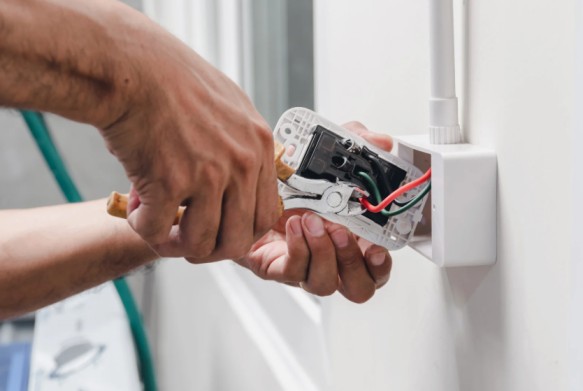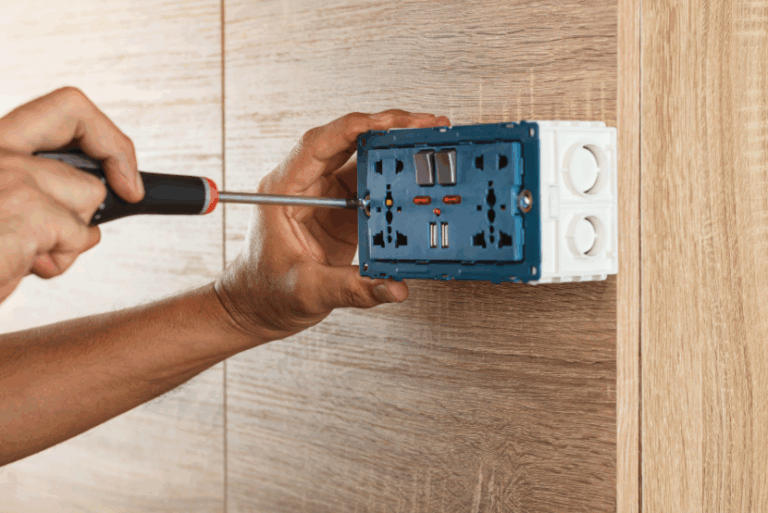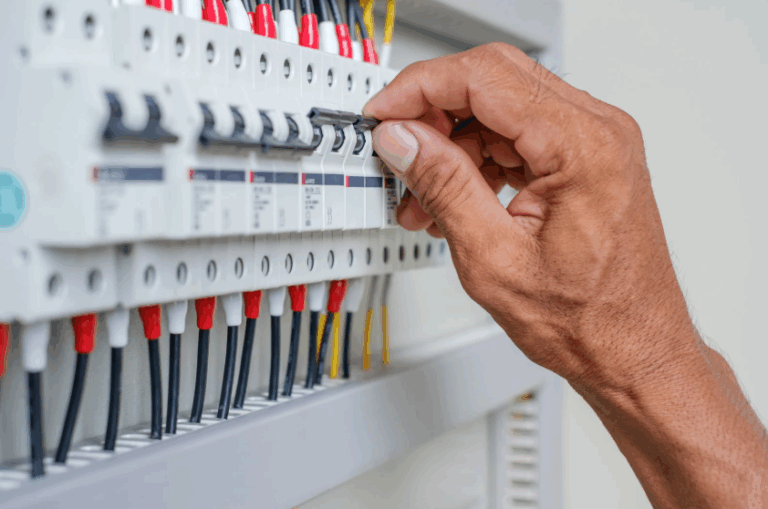If your outlet isn’t working, but the circuit breaker hasn’t tripped, it could be due to loose wiring or a faulty outlet. Sometimes, wiring connections inside the outlet or at the breaker panel may have become loose, preventing power from reaching the outlet.
What to do:
- Inspect the outlet and wiring carefully (ensure the power is turned off first).
- If you’re unsure about any connections, it’s best to call a licensed electrician for assistance.
In this guide, we’ll walk you through the possible causes of a non-working outlet and simple steps to troubleshoot and fix the issue.
Why Is My Electrical Outlet Not Working?
There are several potential reasons why your outlet may not be working, including:
- Tripped Circuit Breaker: A tripped breaker can stop the outlet from supplying power. Circuit breakers are made to protect your home’s electrical system from overloads.
- Blown Fuse In older homes, a blown fuse might cause the outlet to lose power.
- Faulty Outlet Over time, outlets can wear out or become damaged.
- Loose or Damaged Wiring Loose or frayed wiring inside the outlet or in the wall can cause the outlet to stop working.
- GFCI Outlet Issue: If the outlet is a GFCI (Ground Fault Circuit Interrupter) type, it may have tripped due to moisture or an electrical fault.
How to Fix an Electrical Outlet Not Working

Step 1: Test the Outlet
Check if the outlet is genuinely not working by plugging in a device, like a phone charger or a lamp. If it doesn’t turn on, move to the next step.
Step 2: Check the Circuit Breaker
The first step is to check the circuit breaker panel. If any breakers are flipped to “off” or show a warning light, flip them back to the “on” position to restore power.
Step 3: Check GFCI Outlets
If the outlet is located in a bathroom, kitchen, or another area with moisture, it may be a GFCI outlet. Press the “reset” button on the outlet to restore power.
Step 4: Inspect the Outlet
If the breaker and GFCI are fine, inspect the outlet for signs of visible damage, like burn marks or cracks. A damaged outlet may need to be replaced.
Step 5: Test the Wiring
If you feel comfortable with electrical work, turn off the power to the outlet and use a voltage tester to check if power is reaching the outlet. If not, the wiring may need to be repaired or replaced.
Inspect the Outlet for Damage
If your outlet is still not working after resetting the GFCI or breaker, the next step is to visually inspect the outlet for any damage.
What to look for:
- Discoloration or Burn Marks: These signs may indicate overheating, short circuits, or wiring issues.
- Cracks or Fractures: Physical damage could mean that the outlet is no longer functional.
Safety Tip:
- If you notice any signs of damage, turn off the power at the breaker before attempting any further inspection or repairs.
- A damaged or burnt outlet should always be replaced by a qualified electrician to prevent fire hazards.
Can an electrical outlet go bad?
Yes, outlets can go bad over time, especially with constant use. A damaged outlet may lose its ability to properly transmit power, or internal wiring may deteriorate.
Signs of a bad outlet:
- The outlet feels warm to the touch.
- Devices plugged into it don’t receive power.
- Visible damage such as burn marks or cracking.
Reset a Tripped GFCI Outlet
Some outlets are Ground Fault Circuit Interrupter (GFCI) outlets, which are designed to protect you from electrical shocks. These outlets have two buttons labeled “Test” and “Reset.”
What to do:
- Locate GFCI outlets in areas such as bathrooms, kitchens, and garages.
- Press the “Reset” button to restore power to the outlet.
If you don’t see a reset button on the non-working outlet itself, check nearby outlets. Some GFCI outlets control multiple outlets, so pressing the reset button on one outlet can restore power to the others.
When to Call an Electrician
If your outlet is still not working after trying these steps, it’s best to call a licensed electrician. Electrical issues can be hazardous, and a professional can ensure everything is handled safely.
Why call a professional:
- Electrical work can be dangerous if done incorrectly.
- An electrician can safely inspect and repair wiring issues, replace faulty outlets, or resolve more complex problems with your electrical system.
Preventing Future Outlet Problems
To keep your outlets functioning properly:
- Don’t overload outlets by plugging in too many devices.
- Inspect outlets regularly for signs of wear and tear.
- Use surge protectors to prevent damage from power surges.
Conclusion
An electrical outlet not working can usually be fixed with a little troubleshooting. By following these steps, you can quickly restore power to your outlet. If you’re unsure or if the issue persists, it’s always safest to contact a professional.
FAQ
Why is my outlet not working, but the breaker is not tripped?
It could be due to a faulty outlet or loose wiring. Check the wiring or consult an electrician.
What should I do if my outlet reset button won’t push in?
If the reset button on a GFCI outlet won’t press, the outlet might be faulty or have an electrical issue. Replace it or call an electrician.
How do I know if I have a loose wire in my outlet?
Look for sparking or warmth when using the outlet. Turn off the power and inspect the outlet for loose connections.
Can I reset an outlet without a reset button?
No, if it doesn’t have a reset button, check the circuit breaker for a tripped switch.
Why does my GFCI outlet trip so often?
It could be due to moisture, a faulty appliance, or overloaded circuits. Unplug devices and try resetting the outlet.
Why does my outlet work intermittently?
Loose wiring or a faulty outlet might cause intermittent issues. Inspect the outlet or call an electrician.




